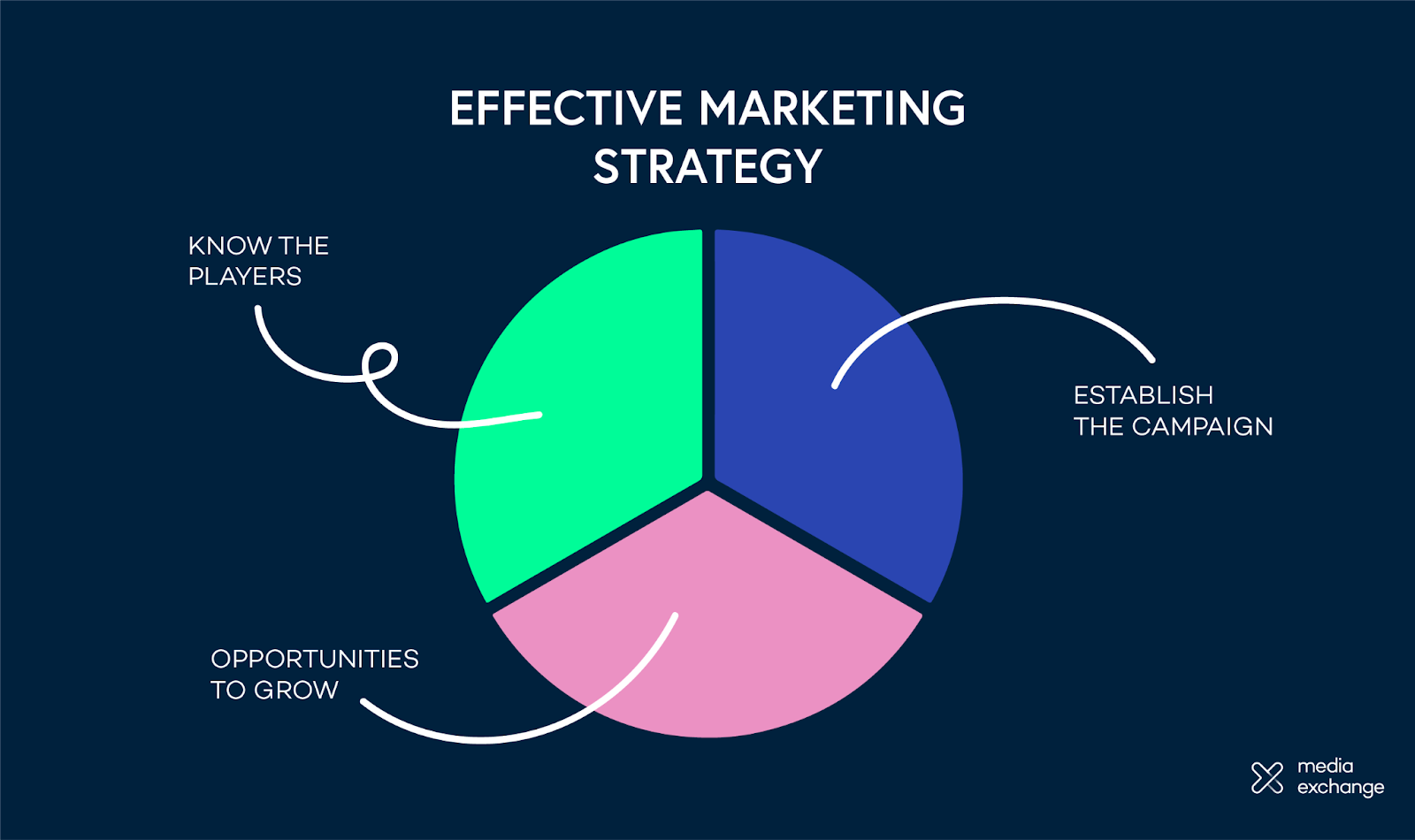A strong, clear and well-researched marketing strategy is essential for businesses to get — and maintain — a presence in the market. Advertising is a daily constant, and people are exposed to an ever-increasing number of messages and brands every day. Your marketing strategy is what gets you the attention of consumers.
But what is a marketing strategy? It’s the game plan, the overall schematic that defines everything you do in terms of advertising, promotion and publicity. Without a strategy, you might just be aimlessly putting out messages and getting no responses. Knowing at least the basics of marketing strategy development can be the gap between early success and failure.
If you’re new to the game, or looking to shore up your existing marketing, let our knowledge and expertise guide you through the key elements of a marketing strategy to help you win your market.
Why is a marketing strategy important?
The importance of a marketing strategy is made clear when you think of marketing as a conversation between your brand and consumers; you need to let them know what you can offer them that’s different. A marketing communication strategy is, at its heart, your approach to this conversation — what you want to say, and how you want to say it.
Your overall marketing strategy plan informs and encompasses all the following individual strategies:
- Digital marketing strategy
- Content marketing strategy
- Social media marketing strategy
- SEO marketing strategy
- Brand marketing strategy
Building a marketing strategy
There is no single ‘how to write a marketing strategy’ guide that suits every business. Industries are too diverse and consumers too savvy for brands to rely on templates. But we think there are some components of a marketing strategy that are absolutely key to know.
Every brand should endeavour to be unique and not too similar to competitors, but every effective marketing strategy naturally has some things in common. The purpose of marketing strategy development is to use common strategy frameworks with unique, brand-appropriate messages and advertising.

Know the players
You
What are your values? What is your mission? How you answer these questions informs everything about your marketing. Who you want to target, how you want to sell and what you want to achieve are all born from your brand mission.
If you don’t have a mission, try and develop a concise statement that includes what you stand for, and what you are trying to deliver to your customers. Consider how your values fill a gap in the market, and let this inform your mission.
Competitors
If marketing is about communication, why would you want to tell consumers something they are already hearing from your competitor? Examine what your competitors are doing; identify the tactics that are succeeding and failing. And perhaps most importantly, figure out what all your competitors combined are not doing.
There are inevitably some gaps in the market, and these are natural opportunities for you to fill. Find the niches and locations that you can fill where competitors are missing.
Consumers
Having a customer driven marketing strategy is integral because without them, you’re just spending money without making any. But not every person out there is relevant for you to target — your marketing strategy objective is knowing and reaching the right people.
Use your existing sales data and some external research into the market to identify who typical consumers are, including people you could target that your competitors aren’t. Try and develop personas: breakdowns of individual consumers by their demographic information, hobbies, digital behaviours and purchase channels. These ‘ideal customers’ help ground marketing strategy development in reality.
Also consider ‘pain points’: the specific issues faced by customers, both those you already have and those you are trying to reach. Common pain points relate to product price, a lack of convenience, and poor service — how can you address these?
Establish the campaign
Channels
Deciding where to place your messages naturally flows from understanding your audience. Crafting your message for the particular audience is how you get their attention, and you can extend this by tailoring it to the unique features of each platform.
Prioritise the channels that your target audience uses most; being across all media all the time sounds like the best way to reach people, but so much of the money you spend will not be recouped because you are reaching irrelevant consumers. Spending less overall money on the right channels is the way to go.
Goals
There’s little point doing all the work without establishing how to know if your marketing strategy is working. Clearly defining your campaign goals is the only real way to understand the effectiveness of a marketing strategy and properly evaluate success.
The most obvious goal is to generate revenue and make money, but while this is important, goals do not have to be based on money. Success can be new leads, website clicks, social media followers or overall brand awareness. Use the SMART framework to guide your goal-setting.
Optimisation
Your marketing strategy is your game plan, but the game can change unexpectedly. There’s no set-and-forget — you need to review each individual segment to check if anything is changing. If your audience isn’t using the platform you predicted or new trends emerge, you need to be ready to adapt.
It’s not all reactive though! As your campaign runs, the data you collect on purchases, customers and impressions can be used for proactive optimisation. One channel may be significantly more effective at leading to conversions. Some segments of the audience may be more responsive. Leverage your data to make improvements to your campaign.
Opportunities to grow
SEO
Another brand-building practice is search engine optimisation (SEO), which is all about improving elements of your website to make it more relevant and user-friendly. SEO can be a bit tricky when you’re new to it, so understanding how to measure it properly and what to avoid will give you important knowledge to help you scale and grow.
The primary objective of search engines is to serve users with the most accurate and relevant information when they perform searches, so if your content is not relevant to the search request, there’s a good chance it won’t appear high in search results.
SEO focuses on understanding your audience to ensure your site provides a good user experience, which can result in it appearing higher in search results. The higher your site ranks, the more people trust your brand, and the more persuasive your accompanying ads become!
Content
Marketing doesn’t always need to be deliberately persuasive either. Content marketing is about providing informative and relevant content for audiences, including blogs, social media posts and videos. While not geared towards making a sale, these types of published content help to build your brand reputation and consumer trust, augmenting your other marketing communications.
Agencies
For newer brands, or those stuck trying to break into a cluttered market, a media agency can provide useful experience and marketing strategy services that help push you to the next level. It may feel like ‘passing the buck’, but most agencies want to collaborate with you in the process to plan a creative marketing strategy that you are proud to use. They don’t want to steal the spotlight — they want to shine it brighter on you!
If you need a startup or small business marketing strategy, a marketing strategy agency can provide the early expertise you need to get your foot firmly in the door.
Win the market!
Creating a consistent style of communication and marketing strategy is a process that takes time, effort, and continuous review. But when those leads flow and engagement rises, the payoff makes every effort worth it. Following these tips will put you in a good position to take control of your share of the market — go start winning!

